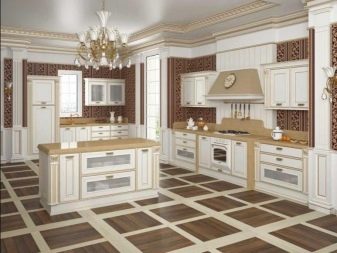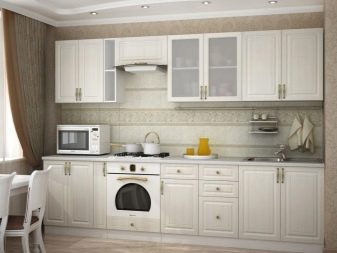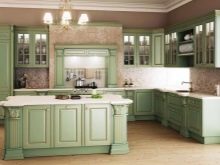Light kitchens in classic style

Classic style kitchens have not lost their relevance for many years. It is the embodiment of respect for family traditions and values. Such kitchens look especially impressive in light shades.

Style features
The main distinguishing features of the classics are sophistication of forms, exceptional symmetry and balanced color palette. The interiors of kitchens decorated in this style look very expensive and aristocratic. At the same time, the style is considered universal - it is suitable for both small kitchens and spacious ones. If you choose the right furniture and buy high-quality and practical finishing materials, a bright classic-style kitchen will delight you for many years.






The classics are characterized by pomp, in contrast to styles such as country or Provence. Here, the designers adhere to strict geometric lines - we can say that this is an aristocratic flawless solution for the kitchen. Large windows and high ceilings create a sense of light and space, while delicate shades and noble furniture emphasize the well-being and status of the family.




Following clear geometric shapes leaves an imprint on the design of the kitchen space - furniture in most cases is placed in a straight line, although corner options are also acceptable. As for the materials used, only natural ones are suitable for classics - wood massifs and natural stones. That is why cedar, beech, oak or cherry wood are usually used for the production of furniture and decoration. However, such repairs are associated with significant costs, which is why most modern kitchens use artificial stoves that mimic the texture of natural materials.




Lighting devices deserve special attention - the classics do not accept the abundance of lamps, here the emphasis is on one massive chandelier with forged elements and glass pendants - such a lamp is placed in the very center of the kitchen and supplemented with several single light sources above the working area.




Next, we will consider what materials, shades and design solutions are best used to decorate a classic light kitchen.
Materials (edit)
Classics are the style of real aristocrats, so for many years only natural materials were used to implement this trend in practice. They are very beautiful, expensive, but sometimes completely impractical. That is why modern trends have made a tilt in favor of artificial coatings that imitate natural wood or stone.

Walls
A variety of finishing materials are used to decorate walls in a classic interior. Decorative plaster is an environmentally friendly coating that optimally conceals all irregularities and defects in coatings and is quite easy to repair. Typically, for a classic-style kitchen, Venetian plaster is used that imitates natural stone, thanks to a luxurious shade with a copper sheen, the effect of a glow from the inside is created. The only drawback of such coverage is its overpriced.


Matte paint is the cheapest and easiest finish. Walls painted with such a composition look stylish and, at the same time, are quite easily cleaned of dirt and greasy stains.


Wallpaper - vinyl works well for the kitchen. If the kitchen is small, then it is better to use a monochromatic cladding, and if the area of your kitchen is very large, then wallpaper with vertical stripes, small floral patterns or all kinds of openwork patterns will do. In this case, the drawing should be unobtrusive.


Panels - wood panels look very expensive and rich, besides, they are strong and durable. The highest quality slabs are made from cedar and oak, while cheaper options are made from pine or alder. A good alternative to wood would be MDF with an imitation of natural texture.


Floor
There are several options for floor finishing when implementing a classic style in the kitchen. Granite or marble are luxurious, durable, wear-resistant and durable materials that retain their invariably luxurious appearance for several decades. The main disadvantage of such a coating is its very high cost.


Parquet - this covering was popular in the Soviet era, but today it has not lost its relevance in classic interiors. It looks spectacular and is pleasant to the touch, is cheaper, but impractical. To increase the life of the coating, it is treated with varnishes and wax, only specialized formulations are used for washing and periodically rubbed with special pastes.


Laminate - a modern alternative to parquet, as a rule, it imitates wood of dark and light species, is not afraid of wet cleaning and is resistant to mechanical damage.


Tile is the most practical option, which is characterized by increased resistance to wear, moisture and abrasion, the material is fireproof and practical. In addition, the cost of a ceramic slab is quite affordable, so even people with an average income can afford such a facing.


Ceiling
In the classic version, the ceilings should be perfectly aligned and then painted with white paint. If there are defects and irregularities on the surface, then it is better to install drywall and paint its surface already. Smooth shelves are often complemented with stucco molding, and baseboards are attached around the perimeter.

Furnishings
Kitchen sets should be made only of natural wood and the most expensive upholstery materials. Synthetic surfaces, as well as the abundance of metal, do not harmonize with the classics, so their number should be minimal.

Popular shades
Classics require noble light shades, the kitchen can be beige, ivory, as well as light green, pale gray or olive. Blue, pistachio, light blue, light yellow, salmon, pink and cream colors are allowed. All these shades have one thing in common - they are considered neutral, and therefore, they cannot get bored or tired, as is often the case if the room is decorated in red, deep blue and brown tones.

In addition, light shades visually increase the area of the kitchen and visually raise the ceilings, therefore, create a feeling of lightness, airiness and fullness of sunlight. To emphasize this effect, the classics are often complemented by glossy furniture - it reflects light, and the room becomes even more comfortable and spacious.
In classic interiors, there are always forged and bronze elements, as well as gilding and stucco molding, respectively, in certain proportions, white and shades of precious metals are added to the color palette. However, gold, silver or bronze should not become the main color, they are good for details - handles, curtains or decorative elements.

The patina effect looks very stylish - a slight abrasion of the facing materials. Such accents allow to achieve a special aura filled with history and adherence to classical values. The benefits of patina are obvious.
- Stylish decorative effect - patinated surfaces make the kitchen more luxurious and interesting.
- Practicality - stains and streaks are not so noticeable on the patina.
- Protection - when applying patinated compositions to facades, moisture protection is additionally provided. Accordingly, the service life of such furniture increases significantly.
- Gold bloom on white or beige furniture has always been considered a win-win. It not only makes the kitchen more stylish, but also successfully combines with all other furnishings.

Selection Tips
The approach to buying kitchen furniture is very simple - you need to come to a furniture store, choose the model you like in the product catalog and order it in the required size and color scheme. Usually, the designer sends the measurers to your home and after that draws up a sketch of your future kitchen, then sends it to the production workshop. As a rule, furniture is assembled for about 1.5-2 months, after which it is brought to your home or store.

The whole process takes quite a long time, so in recent years, designer fashion has taken a heck in favor of modular options. Such headsets are a set of several designs that can be easily rearranged from place to place and even positioned one above the other.

Modular options for the kitchen are tables, cabinets and drawers, which are arranged in no particular order. Usually, the same model can be made in 3-5 color options with 10-20 types of cabinets in 3-4 sizes, and already on the spot you will choose the optimal color for yourself and, for example, 6-8 cabinets that ideally match your kitchen space and the functionality assigned to them. Thus, at the time of purchase, you are simultaneously a designer who selects individual options "not like everyone else."


Both methods of buying a kitchen are widespread among Russians, while the main advantage of traditional custom-made kitchen sets is a wide selection of materials used, as well as fittings and all kinds of colors, and the advantages of a model from modules include the ability to independently assemble a set.

Classic kitchens are usually used in the traditional version, as a rule, they are made "semi-antique" and made of solid wood.
Regardless of which option you prefer, before selecting kitchen sets, the following points must be identified:
- desired functionality;
- color palette;
- room parameters - shape, dimensions and location of the window;
- placement of sockets, gas outlets and plumbing connections.

Undoubtedly, the classics do not tolerate cheap things, so the furniture should be of the highest quality. In most cases, the choice of buyers is models made in Russia, in the CIS countries, but if you intend to recreate a truly classic interior in your kitchen, it is better to give preference to headsets made in Germany, Italy and France.
Beautiful examples
A classic kitchen is always decorated in natural shades, most often beige, light cream and gray. White, dairy and creamy rooms look very impressive, as well as those decorated in "ivory" and "eggshell" colors.



However, the classics allow the use of brighter shades - olive, salmon and terracotta are popular, the main thing is that the tone is light and as natural as possible, that is, the way it is found in nature.



There are several principles for the color scheme of the kitchen.
- If your kitchen is too small or darkened, then it is better to use glossy white as the main color. Such a solution will visually expand the space, add light and lighten furniture that is too bulky.

- When designing a classic kitchen, rely on neutral universal shades - cream, light beige or pale gray.

- The safest design option would be a two-tone kitchen, of course, the colors should be related, but in no way contrasting.

- Keep in mind that any metallic shades are good as decorative elements and accessories, aged metals look especially stylish, for example, antique gold, bronze or silver.

For information on how to choose the right design for a light kitchen in the classic style, see the next video.













The comment was sent successfully.